- Home
- Lawrence Block
The Crime of Our Lives Page 7
The Crime of Our Lives Read online
Page 7
Ed Gorman is a terrific writer, and you’re going to have a wonderful time reading these stories.
Now what?
That’s seventeen words. Pete Crowther, who asked me to write this introduction, has given me to understand that introductions to the volumes he publishes run in the neighborhood of a thousand words. That’s not a bad neighborhood, you wouldn’t be afraid to wander there after dark, but the seventeen words I’ve written leave me with nine hundred and eighty-seven words to write, and what am I going to write to take up the slack? I mean, I’ve already said everything I really have to say on the subject. Here are some stories. Read them, and leave me alone. What else is there to say?
Well, I’ll think of something. I am, after all, a professional writer. It is in the nature of a writer to think of something, and it is the hallmark of a professional to then do something with it.
And meanwhile, I’m heartened by the fact that the mere process of thinking about thinking of something has stretched us to . . . ha! 187 words.
Let’s see now. I’ve already told you to read the stories. But here’s a question: Should you read them one right after the other, or should you spread them out over a period of weeks or months?
It’s an interesting point. The short stories of an individual author aren’t meant to be read en bloc, and may suffer from such treatment. Gulp them all down at one sitting and their inevitable similarities could make them seem stale or repetitive.
And little things can rankle. Long ago I read a collection of Flannery O’Connor’s short stories, and halfway through I noticed a curious way in which she was repeating herself. A character in one story had lead-colored eyes. A character in another story had eyes the color of gun metal. And so on, and it struck me that this lady was working her way through the whole catalog of base metals. Call me, I said to myself, when you get to antimony.
On the other hand, it is when one reads a whole book of stories that a writer’s themes emerge. The very similarities in stories that are essentially different give the reader an insight into who the writer is and what he’s about. (And this is particularly valuable for a reader who aspires to become a writer himself. Immerse yourself in the stories of a particular writer—ideally one whom you admire—and you begin to get a clue how he does it.)
So it’s up to you, Gentle Reader. Gulp these stories down, if that’s your pleasure, one right after the other.
Or take your time, and spread them out over a week or a month. If you can.
469 words. Almost halfway there. I told you this would work!
Oh, I know what I could do. The last resort of reviewers from time immemorial. Just go through the stories, one by one, and find something to say about each of them. That’s how we approached book reports in school, summarizing the plot to prove we’d read it, and reviewers still do that, and probably for that very reason.
Not I. I read all of these stories over the past week—and several were ones I’d read years before, and still reread with pleasure. But you’re going to have to take my word for it. They don’t need my comments, and they’re not going to get them.
And even so, we’re up to 596 words.
I did notice a couple of things, reading these stories. (You’ll notice them yourselves, you don’t need me to point them out to you, but too bad. I’ve got words to write here.)
There’s an abiding nostalgia in many of these stories, a sweet recollection of youth in what seemed (but only seemed) a simpler, easier time. There’s a glimpse of the writer in many of the young characters, of the enthusiasm for genre fiction in the boy who would grow up to write genre fiction.
There’s a recurring theme of addictive behavior—alcoholism, compulsive gambling—and its unshakeable effects on the children of addicts.
And there is, most interestingly, an insistence on acknowledging the humanity of all of the characters, even the villains.
“If we could read the secret history of our enemies,” wrote Longfellow in Driftwood, “we should find in each man’s life sorrow and suffering enough to disarm all hostility.”
(And yes, that’s Henry Wadsworth Longfellow, the Nineteenth Century American poet whose reputation has waned over the years—unjustly, I would say. A generation force-fed “Evangeline” in grade school can perhaps be expected to dismiss its author out of hand. A look at Longfellow reveals not only a gifted and disciplined poetic craftsman but a very appealing intellect and sensibility. Do I digress? Indeed I digress, and this particular digression has brought me just past the 830-word mark.)
The secret history of our enemies. To know all may not be to forgive all, unless one is a candidate for canonization, but it does take a lot of the pleasure out of hating, doesn’t it?
If Ed Gorman had never written a single story or novel, the world of American genre fiction would be the poorer for it. But his place in it would be assured all the same.
As a reviewer, as an essayist, as an editor and publisher, as a pure-D champion of the writers and writings he loves, the man has had and continues to have an enormous influence. The boy for whom Gold Medal novels were important has become a man for whom good writing remains vitally important, and he has shared his enthusiasm for it in a genuinely important fashion.
Now all that may or may not be important to you, Gentle Reader. You have a book of stories in your hand, and in a moment or two you’ll get down to the happy business of reading them. But, by taking a moment to point out this other side of Ed Gorman, I’ve done something that’s comparably important, if only to me.
I’ve gotten us fifty words past the thousand-work mark. So this is where I get off.
See ya!
Dashiell Hammett
* * *
This appreciation of Hammett was commissioned by the Japanese edition of Playboy in the mid-1990s, and may well have been timed to coincide with the centenary of his birth in 1894. (GQ ordered up a piece on Raymond Chandler with the same idea in mind, but, as I mentioned above, Chandler had in fact been born in 1888.) As far as I know, the Hammett piece has never appeared in English. Indeed, for all I know it never ran in Japanese, either, as I’ve never seen a copy . . .
“Write about what you know.”
Anyone with an urge to write for publication is likely to hear those words of advice over and over again. According to the conventional wisdom, fiction can only be moving and convincing insofar as it is rooted in the writer’s own experience and informed by his personal knowledge. While your work need not be directly autobiographical, it nevertheless must grow out of who you are and what you have witnessed.
No end of writers have taken this advice and profited from it. Soldiers have come home from war to fill books with their battlefield experience. The children of immigrants have speeded their own assimilation by distilling powerful fiction from their parents’ ordeal. Men and women who have survived abusive childhoods in desperately dysfunctional families have gone on to spill their trauma upon the page, turning it into novels as an oyster turns a grain of sand into a pearl. (The image is an appropriate one; the act of writing at once cauterizes the wound and soothes the hurt, even as it produces something of beauty and of value.)
But of what use is this advice for those of us who would write escape fiction? In the fields of adventure, of mystery, of science fiction, many millions of readers have been diverted by writers who have spent whole lifetimes spinning tales out of the whole cloth. Edgar Rice Burroughs wrote about Tarzan’s adventures in Africa and John Carter’s on Mars, and had no more firsthand experience with the former than the latter. (He thought there were tigers in Africa.) While several ex-cops like Joseph Wambaugh and William Caunitz have turned their experience into strong and successful fiction, the outstanding police procedural series of all time is Ed McBain’s saga of the 87th Precinct. Although McBain’s vocational history includes such exotic jobs as a stint as a lobster salesman, he was never a policeman—but he’s been able to write more than forty enduring novels over as many years about the cops of the
Eight-seven.
The hardboiled private detective, the cynical loner in a trenchcoat, has become an American archetype known throughout the world. But hardly any of us who write about him have hands-on experience to draw upon. So many writers have written so many books with no greater resource than their own imaginations that it’s easy to forget how it all began.
One man started it all. His name was Dashiell Hammett, and he was writing about what he knew.
Samuel Dashiell Hammett was born in rural Maryland on May 27, 1894. The family moved to Philadelphia and then to Baltimore, where he attended high school for a single semester before dropping out at 14. He held various odd jobs until 1915, when, as he later told Black Mask, “An enigmatic want ad took me into the employ of Pinkerton’s National Detective Agency, and I stuck at that until early in 1922, when I chucked it to see what I could do with fiction writing. In between, I spent an uneventful while in the army during the war, becoming a sergeant, and acquired a wife and daughter.”
The Pinkerton organization was the unchallenged leader in its field, its symbol the unblinking eye that never slept. Founded in 1850, the agency had made its reputation solving sensational criminal cases, but by the time of Hammett’s employment the agency’s efforts were increasingly enlisted by western mining and timber interests to harass labor organizers, safeguard scab laborers, and break strikes.
Hammett’s investigative work consisted largely of surveillance and shadowing suspects, and he must have had an aptitude for it. He became ill during the year he spent in military service, suffering from lung disease which was variously diagnosed as influenza and bronchial pneumonia, and which activated tuberculosis he had evidently contracted in childhood. After his discharge he resumed work for Pinkerton’s, and continued as his health allowed. Eventually, discouraged when the premature solution of the theft of a shipment of gold cheated him out of a trip to Australia, he quit to write advertising copy for a San Francisco jeweler—and to see what he could do with fiction writing.
It was his convalescence that led him to writing. He spent days on end in the library, trying to read all the books in it, determined to give himself the education he had missed in his youth. He read widely on all subjects, and discovered that he wanted to become a writer.
He had some success almost at once, selling pieces to The Smart Set, a new magazine that sought to epitomize literary sophistication. His most interesting piece for that magazine was a flip, sardonic essay called “From the Memoirs of a Private Detective.” It’s full of ironic paragraphs and one-liners, among them the following:
“I was once falsely accused of perjury, and had to perjure myself to escape arrest . . .
“I knew a forger who had left his wife because she had learned to smoke cigarettes while he was serving a term in prison . . .
“I was once engaged to discharge a woman’s housekeeper . . .
“I once knew a man who stole a Ferris-wheel.”
The owners of The Smart Set published Black Mask as well. Perhaps they steered Hammett toward Black Mask; perhaps, as he would later tell his friends, he picked up a detective pulp one day and realized he could do much better. In any event, he turned his sights in that direction, and began almost at once to turn out the work which would make him famous. He found a style, the tough and gritty prose which was Black Mask’s gift to literature. And he found a character to give voice to that style in the person of the Continental Op.
“I didn’t deliberately keep him nameless,” Hammett wrote of the Op, “but he got through ‘Slippery Fingers’ and ‘Arson Plus’ without needing [a name], so I suppose I may well let him run along that way. I’m not sure that he’s entitled to a name, anyhow.”
The Op served as Hammett’s hero and narrator in two novels and twenty-eight stories. Unlike his tall and rail-thin creator, the Op was short and fat and middle-aged, and probably owed a good deal to James Wright, Hammett’s mentor at the Pinkerton office in Baltimore. We never learn too much about the Op’s life away from the job, and it seems likely that he doesn’t have one. Like real-life Pinkerton agents of the time, he is on call twenty-four hours a day, and the job seems to be his entire focus.
The Op’s chief role is to investigate, to ask questions and find out answers, but he is also called upon to stir things up and make things happen. In “The House in Turk Street”, the Op is going from door to door looking for a missing youth from Tacoma; one of the doors he knocks on is the hideout of a gang of criminals who’ve stolen $100,00 in bonds. By the time he gets out of there three of the crooks are dead. A fourth is in custody, charged with their murder, and the Op tells him he hadn’t been investigating that case at all.
“But he didn’t believe me,” he adds. “He never believed me. He went to the gallows thinking me a liar.”
The Op became the quintessential hardboiled detective of fiction, a tough-minded window on a nasty world, entirely devoted to the monolithic agency that employs him. He doesn’t feel much, and when emotions somehow intrude he suppresses them. Here’s a revealing passage near the end of The Dain Curse:
“ ‘You’re the nicest man in the world. Except! You sat there this noon and deliberately tried to make me think you were in love with me . . . . I believed you until I came in just now, and then I saw—’ She stopped.
“ ‘Saw what?’
“ ‘A monster. A nice one . . . but a monster just the same, without any human foolishness like love in him, and— What’s the matter? Have I said something I shouldn’t?’
“ ‘I don’t think you should have,’ I said.”
Dashiell Hammett wrote three non-Continental Op novels; one of them, The Maltese Falcon, serves as the cornerstone of his enduring reputation. John Huston’s film, with Humphrey Bogart as Sam Spade and the impeccable supporting cast of Peter Lorre, Sidney Greenstreet, Mary Astor, and Elisha Cook, Jr., deserves a good measure of the credit, but here is an instance—perhaps the only instance in the history of cinema—where the book and the film are literally one and the same.
This is true not because Hammett adapted his book for the screen—he didn’t—but because he wrote the screenplay when he wrote the book. Quite simply, the book is the screenplay—although you’ll see John Huston credited as screenwriter. If you watch the movie, you will find nothing on the screen which does not appear in the book. Every line of dialogue, every bit of action, is just as it appears in Hammett’s novel.
And, if you read the novel, you’ll find nothing on its pages which is not specifically filmable. With the specific intent of making his work filmable, Hammett set out in Falcon to produce a work containing nothing other than what we can see and hear. While all the action is from Sam Spade’s point of view, we are never made privy to his thoughts, and know them only through his visible reactions. In all the books 200+ pages, the only information we’re given which could not be shown on the screen is the particular scent that issues from Joel Cairo’s handkerchief.
Hammett certainly succeeded in making the book attractive to the film industry. The book was published in 1930, and when Huston’s film appeared ten years later it was the third version to hit the screen. The first, originally called The Maltese Falcon but later retitled Dangerous Female, starred Ricardo Cortez, who played Spade as a smirking, slimy type. It was remade in 1936 as Satan Met a Lady, with Bette Davis and Warren Williams. (Arthur Treacher played Joel Cairo, and the fat man, Gutman, is played by a fat lady, Alison Skipworth.)
According to popular legend, Huston had a secretary copy the book in screenplay form so he could see how to adapt it; a studio head came upon the script, took it for finished work, and told the director to go ahead and shoot it. I can’t believe it happened quite that way, but the book and script are such that the story is almost plausible.
Seeking to make his novel more filmable, Hammett achieved as well the more important end of capturing in prose the wonderful objectivity of film. Hammett’s work was objective in attitude from the beginning, but the first-person Continental Op
stories were quite properly seen through their narrator’s eyes and informed by his perceptions. The third-person Falcon was different. Teachers of writing have long enjoined their students to show rather than tell their stories, and I can’t imagine a better instruction manual toward this end than The Maltese Falcon. Everything is shown and nothing is told.
The Maltese Falcon made Hammett famous. His future seemed limitless . . . but he had only two more books to write. The Glass Key came a year after Falcon, and The Thin Man followed in 1934. The Glass Key is a strong book, and the story still holds up; curiously, it was the unacknowledged basis of a film just a few years ago, the Coen brothers’ Miller’s Crossing. The Thin Man, however, is a confused and exhausted book, the last work of a writer who had spent himself.
Throughout the ’30s, Hammett made a lot of money from Hollywood and went through it as fast as he made it. Leftist politics took up much of his attention, and drink, a lifelong addiction, took an increasing toll, as his tolerance dropped while his dependence increased.
During the Second World War, tubercular and alcoholic and in his late forties, he managed the astonishing feat of enlisting in the army, and served as a sergeant in the Aleutian campaign. Afterward he returned to a climate of anti-Communist witch hunts; refusing to cooperate with a Congressional investigation, he served a term in prison for contempt of Congress. The government seized his money for back taxes. His health, never good, continued to deteriorate. He died on January 10, 1961, of lung cancer complicated by emphysema and pneumonia; the autopsy noted as well diseases of his heart, kidneys, liver, spleen, and prostate. He was buried, according to his wishes, at the national military cemetery at Arlington.

 Tanner on Ice
Tanner on Ice Hit Me
Hit Me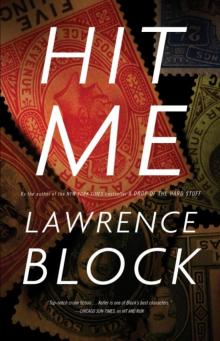 Hit and Run
Hit and Run Hope to Die
Hope to Die Two For Tanner
Two For Tanner Tanners Virgin
Tanners Virgin Dead Girl Blues
Dead Girl Blues One Night Stands and Lost Weekends
One Night Stands and Lost Weekends A Drop of the Hard Stuff
A Drop of the Hard Stuff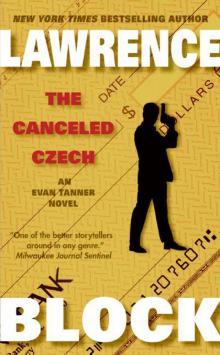 The Canceled Czech
The Canceled Czech Even the Wicked
Even the Wicked Me Tanner, You Jane
Me Tanner, You Jane Quotidian Keller
Quotidian Keller Small Town
Small Town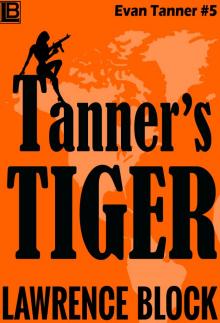 Tanners Tiger
Tanners Tiger A Walk Among the Tombstones
A Walk Among the Tombstones Tanners Twelve Swingers
Tanners Twelve Swingers Gym Rat & the Murder Club
Gym Rat & the Murder Club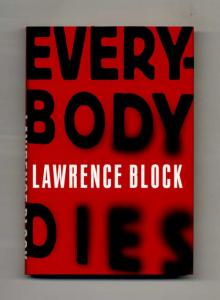 Everybody Dies
Everybody Dies The Thief Who Couldnt Sleep
The Thief Who Couldnt Sleep Hit Parade
Hit Parade The Devil Knows Youre Dead
The Devil Knows Youre Dead The Burglar in Short Order
The Burglar in Short Order A Long Line of Dead Men
A Long Line of Dead Men Keller's Homecoming
Keller's Homecoming Resume Speed
Resume Speed Keller's Adjustment
Keller's Adjustment Eight Million Ways to Die
Eight Million Ways to Die Time to Murder and Create
Time to Murder and Create Out on the Cutting Edge
Out on the Cutting Edge A Dance at the Slaughter House
A Dance at the Slaughter House In the Midst of Death
In the Midst of Death When the Sacred Ginmill Closes
When the Sacred Ginmill Closes You Could Call It Murder
You Could Call It Murder Keller on the Spot
Keller on the Spot A Ticket to the Boneyard
A Ticket to the Boneyard A Time to Scatter Stones
A Time to Scatter Stones Keller's Designated Hitter
Keller's Designated Hitter A Stab in the Dark
A Stab in the Dark Sins of the Fathers
Sins of the Fathers The Burglar in the Closet
The Burglar in the Closet Burglar Who Dropped In On Elvis
Burglar Who Dropped In On Elvis The Burglar Who Painted Like Mondrian
The Burglar Who Painted Like Mondrian The Girl With the Long Green Heart
The Girl With the Long Green Heart The Burglar Who Counted the Spoons (Bernie Rhodenbarr)
The Burglar Who Counted the Spoons (Bernie Rhodenbarr) Burglar Who Smelled Smoke
Burglar Who Smelled Smoke Rude Awakening (Kit Tolliver #2) (The Kit Tolliver Stories)
Rude Awakening (Kit Tolliver #2) (The Kit Tolliver Stories) Don't Get in the Car (Kit Tolliver #9) (The Kit Tolliver Stories)
Don't Get in the Car (Kit Tolliver #9) (The Kit Tolliver Stories) CH04 - The Topless Tulip Caper
CH04 - The Topless Tulip Caper You Can Call Me Lucky (Kit Tolliver #3) (The Kit Tolliver Stories)
You Can Call Me Lucky (Kit Tolliver #3) (The Kit Tolliver Stories) CH02 - Chip Harrison Scores Again
CH02 - Chip Harrison Scores Again Strangers on a Handball Court
Strangers on a Handball Court Cleveland in My Dreams
Cleveland in My Dreams Clean Slate (Kit Tolliver #4) (The Kit Tolliver Stories)
Clean Slate (Kit Tolliver #4) (The Kit Tolliver Stories) The Burglar Who Traded Ted Williams
The Burglar Who Traded Ted Williams Burglar on the Prowl
Burglar on the Prowl In For a Penny (A Story From the Dark Side)
In For a Penny (A Story From the Dark Side) Catch and Release Paperback
Catch and Release Paperback Ride A White Horse
Ride A White Horse No Score
No Score Looking for David (A Matthew Scudder Story Book 7)
Looking for David (A Matthew Scudder Story Book 7) Jilling (Kit Tolliver #6) (The Kit Tolliver Stories)
Jilling (Kit Tolliver #6) (The Kit Tolliver Stories) Ariel
Ariel Enough Rope
Enough Rope Grifter's Game
Grifter's Game Canceled Czech
Canceled Czech Unfinished Business (Kit Tolliver #12) (The Kit Tolliver Stories)
Unfinished Business (Kit Tolliver #12) (The Kit Tolliver Stories) Thirty
Thirty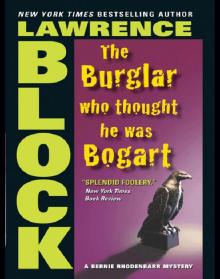 The Burglar Who Thought He Was Bogart
The Burglar Who Thought He Was Bogart Make Out with Murder
Make Out with Murder One Last Night at Grogan's (A Matthew Scudder Story Book 11)
One Last Night at Grogan's (A Matthew Scudder Story Book 11) The Burglar on the Prowl
The Burglar on the Prowl Welcome to the Real World (A Story From the Dark Side)
Welcome to the Real World (A Story From the Dark Side) Keller 05 - Hit Me
Keller 05 - Hit Me Walk Among the Tombstones: A Matthew Scudder Crime Novel
Walk Among the Tombstones: A Matthew Scudder Crime Novel Ronald Rabbit Is a Dirty Old Man
Ronald Rabbit Is a Dirty Old Man The Burglar Who Studied Spinoza
The Burglar Who Studied Spinoza The Burglar Who Liked to Quote Kipling
The Burglar Who Liked to Quote Kipling Keller in Des Moines
Keller in Des Moines Hit List
Hit List The Dettweiler Solution
The Dettweiler Solution HCC 115 - Borderline
HCC 115 - Borderline A Drop of the Hard Stuff: A Matthew Scudder Novel
A Drop of the Hard Stuff: A Matthew Scudder Novel Step by Step
Step by Step The Girl With the Deep Blue Eyes
The Girl With the Deep Blue Eyes If You Can't Stand the Heat (Kit Tolliver #1) (The Kit Tolliver Stories)
If You Can't Stand the Heat (Kit Tolliver #1) (The Kit Tolliver Stories) The Topless Tulip Caper
The Topless Tulip Caper Dolly's Trash & Treasures (A Story From the Dark Side)
Dolly's Trash & Treasures (A Story From the Dark Side) The Triumph of Evil
The Triumph of Evil Fun with Brady and Angelica (Kit Tolliver #10 (The Kit Tolliver Stories)
Fun with Brady and Angelica (Kit Tolliver #10 (The Kit Tolliver Stories) Burglars Can't Be Choosers
Burglars Can't Be Choosers Who Knows Where It Goes (A Story From the Dark Side)
Who Knows Where It Goes (A Story From the Dark Side) Deadly Honeymoon
Deadly Honeymoon Like a Bone in the Throat (A Story From the Dark Side)
Like a Bone in the Throat (A Story From the Dark Side) A Chance to Get Even (A Story From the Dark Side)
A Chance to Get Even (A Story From the Dark Side) The Boy Who Disappeared Clouds
The Boy Who Disappeared Clouds Collecting Ackermans
Collecting Ackermans Waitress Wanted (Kit Tolliver #5) (The Kit Tolliver Stories)
Waitress Wanted (Kit Tolliver #5) (The Kit Tolliver Stories) One Thousand Dollars a Word
One Thousand Dollars a Word Even the Wicked: A Matthew Scudder Novel (Matthew Scudder Mysteries)
Even the Wicked: A Matthew Scudder Novel (Matthew Scudder Mysteries) Hit Man
Hit Man The Night and The Music
The Night and The Music Ehrengraf for the Defense
Ehrengraf for the Defense The Merciful Angel of Death (A Matthew Scudder Story Book 5)
The Merciful Angel of Death (A Matthew Scudder Story Book 5) The Burglar in the Rye
The Burglar in the Rye I Know How to Pick 'Em
I Know How to Pick 'Em Getting Off hcc-69
Getting Off hcc-69 Three in the Side Pocket (A Story From the Dark Side)
Three in the Side Pocket (A Story From the Dark Side) Let's Get Lost (A Matthew Scudder Story Book 8)
Let's Get Lost (A Matthew Scudder Story Book 8) Strange Are the Ways of Love
Strange Are the Ways of Love MOSTLY MURDER: Till Death: a mystery anthology
MOSTLY MURDER: Till Death: a mystery anthology Masters of Noir: Volume Four
Masters of Noir: Volume Four A Week as Andrea Benstock
A Week as Andrea Benstock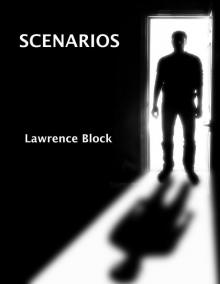 Scenarios (A Stoiry From the Dark Side)
Scenarios (A Stoiry From the Dark Side) The Sex Therapists: What They Can Do and How They Do It (John Warren Wells on Sexual Behavior Book 15)
The Sex Therapists: What They Can Do and How They Do It (John Warren Wells on Sexual Behavior Book 15) Like a Thief in the Night: a Bernie Rhodenbarr story
Like a Thief in the Night: a Bernie Rhodenbarr story A Diet of Treacle
A Diet of Treacle Community of Women
Community of Women Different Strokes: How I (Gulp!) Wrote, Directed, and Starred in an X-rated Movie (John Warren Wells on Sexual Behavior)
Different Strokes: How I (Gulp!) Wrote, Directed, and Starred in an X-rated Movie (John Warren Wells on Sexual Behavior) You Don't Even Feel It (A Story From the Dark Side)
You Don't Even Feel It (A Story From the Dark Side) Zeroing In (Kit Tolliver #11) (The Kit Tolliver Stories)
Zeroing In (Kit Tolliver #11) (The Kit Tolliver Stories) The Wife-Swap Report (John Warren Wells on Sexual Behavior)
The Wife-Swap Report (John Warren Wells on Sexual Behavior) Keller's Fedora (Kindle Single)
Keller's Fedora (Kindle Single) Speaking of Lust
Speaking of Lust Everybody Dies (Matthew Scudder)
Everybody Dies (Matthew Scudder) Defender of the Innocent: The Casebook of Martin Ehrengraf
Defender of the Innocent: The Casebook of Martin Ehrengraf After the First Death
After the First Death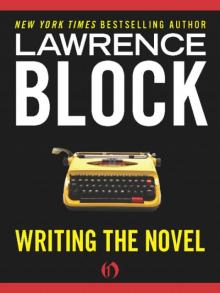 Writing the Novel
Writing the Novel How Far - a one-act stage play
How Far - a one-act stage play Chip Harrison Scores Again
Chip Harrison Scores Again The Topless Tulip Caper ch-4
The Topless Tulip Caper ch-4 The Crime of Our Lives
The Crime of Our Lives Killing Castro
Killing Castro The Trouble with Eden
The Trouble with Eden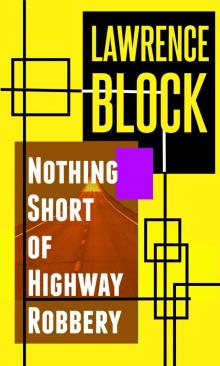 Nothing Short of Highway Robbery
Nothing Short of Highway Robbery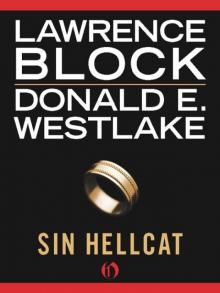 Sin Hellcat
Sin Hellcat Getting Off: A Novel of Sex & Violence (Hard Case Crime)
Getting Off: A Novel of Sex & Violence (Hard Case Crime) Coward's Kiss
Coward's Kiss Alive in Shape and Color
Alive in Shape and Color Blow for Freedom
Blow for Freedom The New Sexual Underground: Crossing the Last Boundaries (John Warren Wells on Sexual Behavior Book 10)
The New Sexual Underground: Crossing the Last Boundaries (John Warren Wells on Sexual Behavior Book 10) April North
April North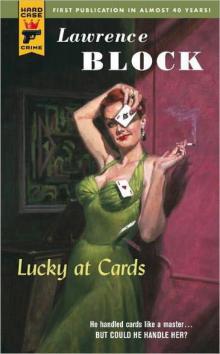 Lucky at Cards
Lucky at Cards One Night Stands; Lost weekends
One Night Stands; Lost weekends Sweet Little Hands (A Story From the Dark Side)
Sweet Little Hands (A Story From the Dark Side) Blood on Their Hands
Blood on Their Hands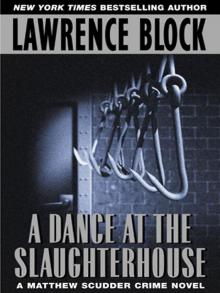 A Dance at the Slaughterhouse
A Dance at the Slaughterhouse Headaches and Bad Dreams (A Story From the Dark Side)
Headaches and Bad Dreams (A Story From the Dark Side) Keller's Therapy
Keller's Therapy The Specialists
The Specialists Hit and Run jk-4
Hit and Run jk-4 Threesome
Threesome Love at a Tender Age (John Warren Wells on Sexual Behavior)
Love at a Tender Age (John Warren Wells on Sexual Behavior) The Devil Knows You're Dead: A MATTHEW SCUDDER CRIME NOVEL
The Devil Knows You're Dead: A MATTHEW SCUDDER CRIME NOVEL Funny You Should Ask
Funny You Should Ask CH01 - No Score
CH01 - No Score Sex and the Stewardess (John Warren Wells on Sexual Behavior)
Sex and the Stewardess (John Warren Wells on Sexual Behavior) A Madwoman's Diary
A Madwoman's Diary When This Man Dies
When This Man Dies Sinner Man
Sinner Man Such Men Are Dangerous
Such Men Are Dangerous A Strange Kind of Love
A Strange Kind of Love Enough of Sorrow
Enough of Sorrow 69 Barrow Street
69 Barrow Street A Moment of Wrong Thinking (Matthew Scudder Mysteries Series Book 9)
A Moment of Wrong Thinking (Matthew Scudder Mysteries Series Book 9) Eight Million Ways to Die ms-5
Eight Million Ways to Die ms-5 Warm and Willing
Warm and Willing Mona
Mona In Sunlight or In Shadow
In Sunlight or In Shadow A Candle for the Bag Lady (Matthew Scudder Book 2)
A Candle for the Bag Lady (Matthew Scudder Book 2) Conjugal Rites (Kit Tolliver #7) (The Kit Tolliver Stories)
Conjugal Rites (Kit Tolliver #7) (The Kit Tolliver Stories) Speaking of Lust - the novella
Speaking of Lust - the novella Gigolo Johnny Wells
Gigolo Johnny Wells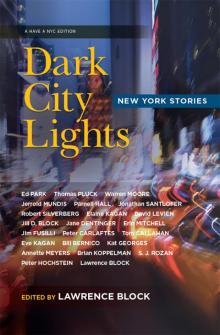 Dark City Lights
Dark City Lights Versatile Ladies: the bisexual option (John Warren Wells on Sexual Behavior)
Versatile Ladies: the bisexual option (John Warren Wells on Sexual Behavior) Passport to Peril
Passport to Peril The Taboo Breakers: Shock Troops of the Sexual Revolution (John Warren Wells on Sexual Behavior)
The Taboo Breakers: Shock Troops of the Sexual Revolution (John Warren Wells on Sexual Behavior) Lucky at Cards hcc-28
Lucky at Cards hcc-28 Campus Tramp
Campus Tramp 3 is Not a Crowd (John Warren Wells on Sexual Behavior)
3 is Not a Crowd (John Warren Wells on Sexual Behavior)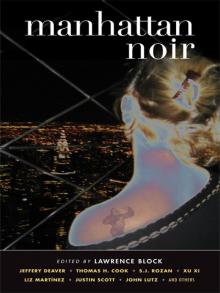 Manhattan Noir
Manhattan Noir The Burglar in the Library
The Burglar in the Library Doing It! - Going Beyond the Sexual Revolution (John Warren Wells on Sexual Behavior Book 13)
Doing It! - Going Beyond the Sexual Revolution (John Warren Wells on Sexual Behavior Book 13) So Willing
So Willing The Burglar Who Traded Ted Williams br-6
The Burglar Who Traded Ted Williams br-6 Candy
Candy Sex Without Strings: A Handbook for Consenting Adults (John Warren Wells on Sexual Behavior)
Sex Without Strings: A Handbook for Consenting Adults (John Warren Wells on Sexual Behavior) The Devil Knows You're Dead: A MATTHEW SCUDDER CRIME NOVEL (Matthew Scudder Mysteries)
The Devil Knows You're Dead: A MATTHEW SCUDDER CRIME NOVEL (Matthew Scudder Mysteries) Manhattan Noir 2
Manhattan Noir 2 The Scoreless Thai (aka Two For Tanner)
The Scoreless Thai (aka Two For Tanner)